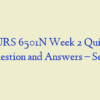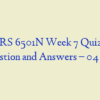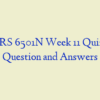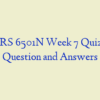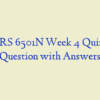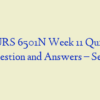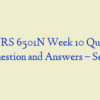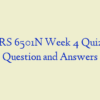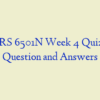Description
NURS 6501N Week 5 Quiz 2 – Question and Answers (30 out of 30)
- When a person is in shock, a nurse remembers impairment in cellular metabolism is cause by:
- A nurse is planning care for a patient in shock. Which principle should the nurse remember? During shock states, glucose uptake is usually:
- A 15-year-old male who is allergic to peanuts eats a peanut butter cup. He then goes into anaphylactic shock. Which assessment findings will the nurse assess for?
- A nurse is explaining the function of the heart. Which is a correct response by the nurse? A function of the pericardium is to:
- A newborn child is diagnosed with tetralogy of Fallot. What symptoms would the nurse expect to observe in the child?
- Which is the most common type of congenital heart defect the nurse should assess for in infants?
- An 8-week-old infant presents to her primary care provider for a well-baby check. Physical exam reveals a murmur, and an echocardiogram shows a large ventricular septal defect. If left untreated, what condition should the nurse discuss with the parents?
- A nurse is teaching a patient about anaphylactic shock. Which information should the nurse include? The onset of anaphylactic shock is usually:
- A 1-month-old infant was diagnosed with truncus arteriosus (TA) with a ventricular septal defect. Which of the following would the nurse also expect? nurs 6501n week 5
- When a patient asks the nurse what is the most common cause of myocardial ischemia, which statement is the correct response? The most common cause of myocardial ischemia is:
- An infant undergoes an echocardiogram for a suspected heart defect. Tests reveal an opening in the middle of the atrial septum. What term would the nurse use to describe this defect?
- A 56-year-old male presents to his primary care provider for a checkup. Physical exam reveals edema, hepatomegaly, and muffled heart sounds. Which of the following is of greatest concern to the nurse?
- A 75-year-old obese female presents to her primary care provider reporting edema in the lower extremities. Physical exam reveals that she has varicose veins. Upon performing the history, which of the following is a possible cause for the varicose veins?
- A 27-year-old male is admitted to a neurologic unit with a complete C-5 spinal cord transection. On initial assessment, he is bradycardic, hypotensive, and hyperventilating. He appears to be going into shock. The most likely mechanism of his shock is:
- Which of the following lab tests will the nurse check to help diagnose heart failure and provide insight into its severity?
- A 3-year-old male is diagnosed with Kawasaki disease. Which of the following does the nurse suspect is the most likely cause?
- A 50-year-old male was admitted to the intensive care unit with a diagnosis of acute myocardial infarction (MI). He is being treated for shock. His cardiopulmonary symptoms include low blood pressure, tachycardia, and tachypnea. His skin is pale and cool. The primary cause of his shock is most likely:
- A 2-week-old infant presents with poor feeding, fatigue, dyspnea, and a murmur. She is diagnosed with a patent ductus arteriosus (PDA). A nurse recalls this condition results in a(n):
- A 52-year-old female is admitted to the cardiac unit with a diagnosis of pericarditis. She asks the nurse to explain where the infection is. In providing an accurate description, the nurse states that the pericardium is:
- A newborn baby is severely cyanotic. An echocardiogram reveals transposition of the great arteries. A nurse assesses for which of the following, as it usually occurs with this defect?
- A newborn is suspected of having coarctation of the aorta. Which of the following assessments would aid in diagnosis? nurs 6501n week 5
- A 22-year-old pregnant female presents for a fetal echocardiogram. Tests reveal a small left atrium and mitral valve and an absent left ventricle and aortic valve. The diagnosis is hypoplastic left heart syndrome (HLHS). The nurse will anticipate that the treatment for this defect is:
- A 67-year-old female was previously diagnosed with rheumatic heart disease. Tests reveal lipoprotein deposition with chronic inflammation that impairs blood flow from the left ventricle into the aorta. Which of the following is the most likely diagnosis recorded on the chart?
- What factors make a patient prone to neurogenic shock? Neurogenic shock can be caused by any factor that inhibits the:
- A newborn child has a murmur and cyanosis. An echocardiogram reveals that the tricuspid valve failed to develop and no blood flows between the right atrium and ventricle. What term will the nurse use to describe this condition? Tricuspid:
- While planning care, the nurse remembers which principle? In valvular _____, the valve opening is constricted and narrowed because the valve leaflets, or cusps, fail to open completely.
- A 20-year-old female is being admitted to the hospital with fever and septic shock. Which set of assessment findings would the nurse expect the patient to exhibit?
- A nurse recalls the most common cardiac valve disease in the United States, which tends to be most prevalent in young women, is:
- For an infection to progress to septic shock, which of the following factors should the nurse determine occurred? nurs 6501n week 5
- A newborn is diagnosed with congenital heart disease. Which of the following intrauterine factors should the nurse focus on during the history that could have caused this disorder?



